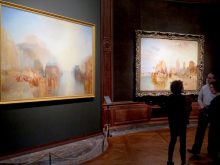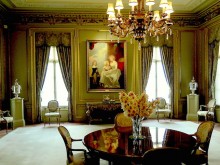Less than forty years after its glorious reception at London’s Royal Academy in 1895, Frederic Leighton’s extraordinary painting “Flaming June” fell from favor and disappeared from view—only to be unearthed in 1962 behind a false panel of a mantelpiece in a house on the outskirts of London.
With a narrative nearly as captivating as its aesthetic appeal, Leighton’s celebrated painting of a sleeping woman draped in a brilliant orange gown is now on view in New York City for the first time at The Frick Collection in an exhibition organized by Susan Grace Galassi, Senior Curator.
One of the most renowned artists of the Victorian era, Leighton painted his masterpiece in the last year before his death, which is, perhaps, foreshadowed by the symbol of the bouquet of oleander above the sleeping maiden. Inspired in part by Michelangelo’s sculpture “Night,” as well as the erotic painting “Leda and the Swan,” Leighton’s “Flaming June” suggests the inherent eroticism of an illusionary Mediterranean setting. Leaving behind no written explanation about the painting’s meaning, Leighton bequeaths “Flaming June” as his definitive statement on Aestheticism, the school of art that emphasized formal beauty over content.
The only British artist to have been ennobled, becoming Lord Leighton, Baron of Stretton, Leighton served as a president of the Royal Academy, where “Flaming June” was first displayed to critical acclaim. “Despite the painting’s renown,” states Galassi, “it has never before been exhibited in New York.” Having passed through several private collections in the early 20th century, the painting was forgotten before its rediscovery in 1962, whereafter it was purchased by Luis Ferré, the founder of Museo de Arte de Ponce in Puerto Rico, where the painting has remained one of the collection’s signature works.
From June 9 through September 6, 2015, the single-work exhibition remains installed in the center of The Frick Collection’s Oval Room, surrounded by four full-length portraits by James McNeill Whistler, a London contemporary of Leighton, whose work was also influenced by the Aesthetic movement. The interplay between Whistler’s distinctly modern style and Leighton’s neo-classical principles provides a complementary context for understanding the milieu and manners of Aestheticism and its adherents.
The exhibition ‘Leighton’s Flaming June’ is accompanied by a small framed oil sketch that Leighton made in preparation of the painting’s palette, as well as an illustrated catalogue and a series of public programs.
Established by Henry Clay Frick, The Frick Collection opened in 1935. Guided by the mandarin aesthetics of the discerning art dealer Joseph Duveen, Frick, who had a remarkable eye for acquisition, amassed a superlative art collection, leaving 137 paintings to the museum upon his death.
Apart from the Collection’s three Vermeers (out of a global total of a possible 37) as well as superb examples of Old Master and 19th-century paintings, the museum also houses French, Italian, and English furniture, Limoges enamels, Sèvres and Chinese porcelains, clocks and carpets.








